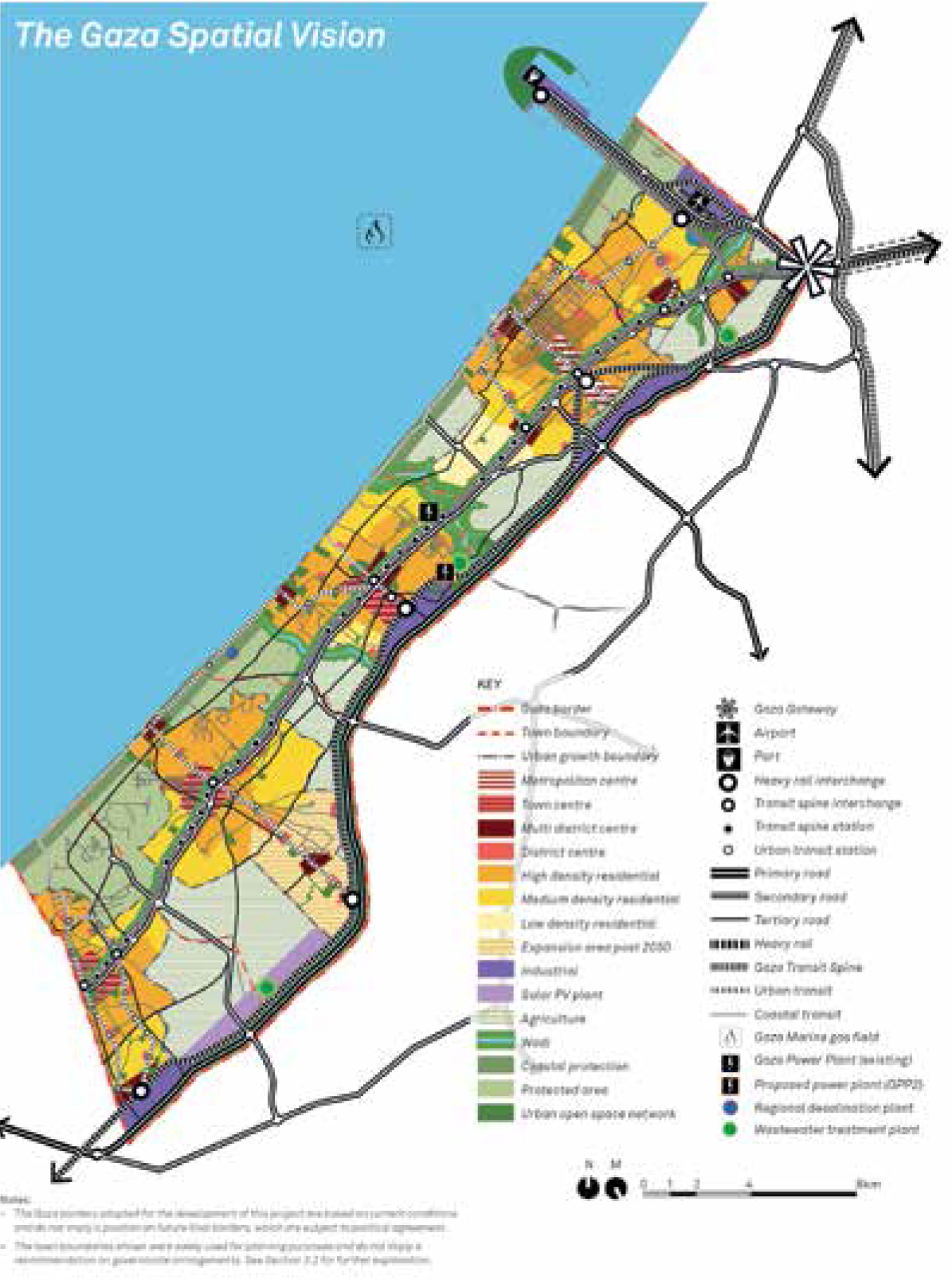Gaza is not only a part of Palestine geographically or in terms of political boundaries, it is also profoundly rooted in the heart of the Palestinian nation and its people – emotionally, socially, and economically.
Palestine faces a set of severe long-standing challenges that hinder economic and social development, negatively affecting both its current population and the generations to come. In Gaza, issues are particularly acute. A stagnant economy; high unemployment; major deficiencies in the provision of housing, energy, and water infrastructure; demographic imbalances; profound internal and regional inequalities and environmental degradation are just some of the most pressing.
The sense of responsibility towards the dire humanitarian situation in Gaza is what motivated a group of Palestinian private-sector representatives to support and fund a neutral and professional study titled “Global Palestine, Connected Gaza” or “Gaza Vision 2050.” The study offers proposals for immediate and future solutions to the problems that the Gaza Strip faces, with special emphasis on energy, water, and physical space.
Responding to a sense of collective responsibility, the following entities contributed towards funding the study: Consolidated Contractors Company (CCC), Palestine Investment Fund (PIF), Bank of Palestine (BoP), Palestine Real Estate Investment Company (PRICO), and The Paltel Group Foundation.

The Global Palestine, Connected Gaza study was prepared by AECOM, one of the world’s leading spatial and urban planning firms, in conjunction with The Portland Trust, which provided the economic context for the vision. The work was carried out in close coordination with a wide range of local and international stakeholders in Gaza and the West Bank. The resulting spatial vision proposes an integrated approach to four key elements that include urban development, transportation, energy and water, and the environment and open spaces. These key elements, in turn, provide an overarching framework for the implementation of what the study terms catalytic projects. Through these, the plan recognizes Gaza’s pressing priorities in terms of reconstruction and provision of housing, energy, water, and basic economic needs, and proposes a long-term plan, up to the year 2050, as part of a holistic vision for Palestine.

Recognizing current challenges and urgent needs, most notably in relation to reconstruction, water and energy, housing, environmental degradation, and socioeconomic stagnation, the vision acknowledges political and security conditions, and defines its immediate and short-term principles. However, considering that the status quo is unsustainable, Global Palestine, Connected Gaza assumes that the multilayered system of restrictions that hinder development in Palestine, and in Gaza in particular, will be progressively lifted. Specifically, Global Palestine, Connected Gaza assumes Gaza as open, connected to the West Bank, and equipped with a modern economy that specializes in trade and exchange, and functions as part of an independent Palestinian state.


Specifically, Global Palestine, Connected Gaza proposes over 70 catalytic projects that are intended to help deliver the spatial vision across different timescales, beginning today and lasting up to 2050. The projects, ranging from major infrastructure developments to softer communitydriven undertakings, anticipate engagement from both private and public-sector entities as well as from the international community. Moreover, the initiative highlights concrete investment opportunities in catalytic projects in the medium term, where the private sector can play key roles in realizing important elements of the vision.
To give structure and help establish hierarchy and priority, the proposed projects have been organized into the three categories, namely, foundation projects, integrated projects, and local projects (both location and nonlocation specific). Foundation projects are major investments in specific sectors, which span across Gaza and are of strategic significance to Gaza as a whole. This category comprises, for example, power plants, desalination facilities, a light rail transit system, housing programs, coastal and beach protection and restoration areas, and other programs that support economic development.
Integrated projects are complex, largescale, and multifunctional projects that will deliver transformational change over time. Due to their complexity and scale, they require coordination efforts within various sectors, between the public and private sectors, and across municipal boundaries. These projects include the Gaza seaport, Gaza airport, and the Gaza Gateway that serves as a connection link to the West Bank and to the world.
Local projects are smaller initiatives that support the delivery of the spatial vision. Some local projects are non-location specific and could be implemented in a variety of places across Gaza. Community programs, arts and heritage conservation, and the development of town centers are a few examples of this category. Proposed location-specific local projects comprise the waterfront generation of Gaza City, the regeneration of Gaza’s old city and the Khan Younis town center, and the Mawasi tourism development initiative in Rafah.
The Gaza Vision initiative owes its emergence to a group of funders who are committed to making the vision become a reality, for Gaza and for Palestine, through a number of ongoing actions and activities.
• Engaging experienced and knowledgeable Gaza Vision champions to oversee the project’s coordination on the ground.
• Developing a communication strategy and plan to highlight the vision’s potentials to local and international stakeholders.
• Building strategic partnership with reputable and active international organizations in Palestine, such as the United Nations Development Program (UNDP). This partnership serves to provide a framework of cooperation to facilitate Gaza Vision implementation.
• Conducting a series of intensive and serious meetings, workshops, and lectures in Gaza to build higher visibility of the vision and gain acceptance for the plan.
• Participating in international conferences and forums with the aim of highlighting vision potentials to a wide range of audiences.
• Developing proposals for a number of quick-win projects mainly in the energy and water sectors, and consolidating partnership with associated organizations on the ground.
• Lining up and coordinating Gaza Vision project proposals with related projects that are proposed and funded by international aid organizations that work in Palestine.
• Conducting a consultancy study for the framework of institutional implementation to deliver and achieve Gaza Vision. • Opening dialogues with international financing institutes and other partners to support facilitation of private-sector investment in the Gaza Strip.
Looking forward, we can confidently assert that the Gaza Vision initiative has great potential to change the difficult reality in Gaza and pave the way for a brighter future for Palestine. However, this noble goal requires unrelenting commitment and support as well as focused efforts among all levels of the Palestinian government, national and international stakeholders, and the international community. Gaza deserves our full attention, and it is a great honor to take part in the endeavor of turning Gaza Vision into reality.


